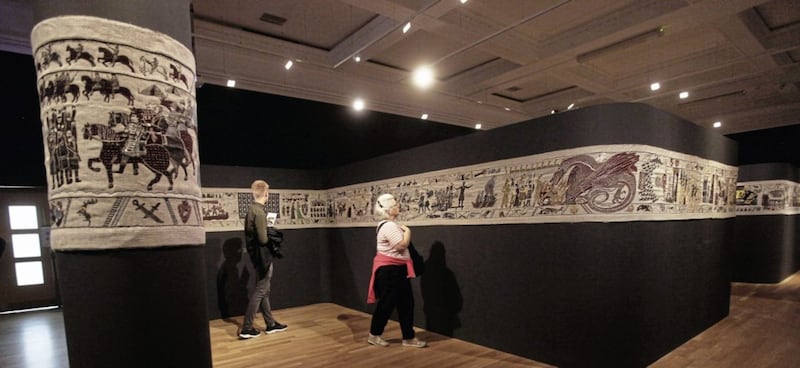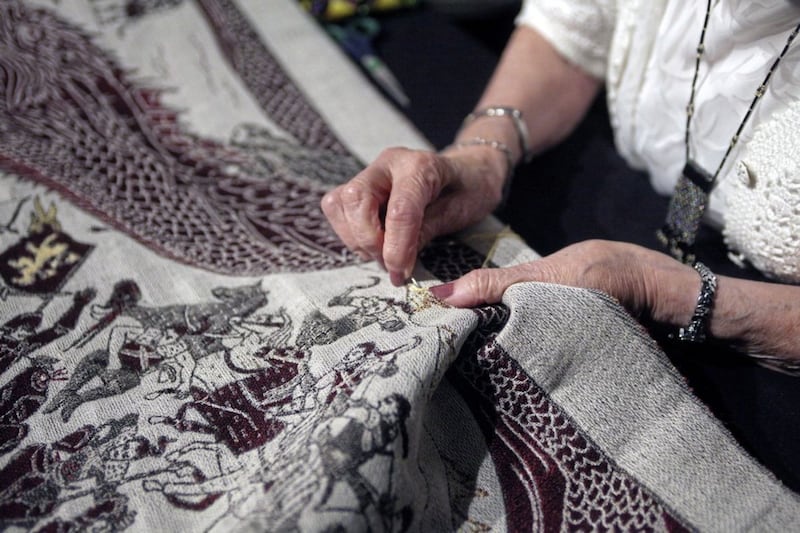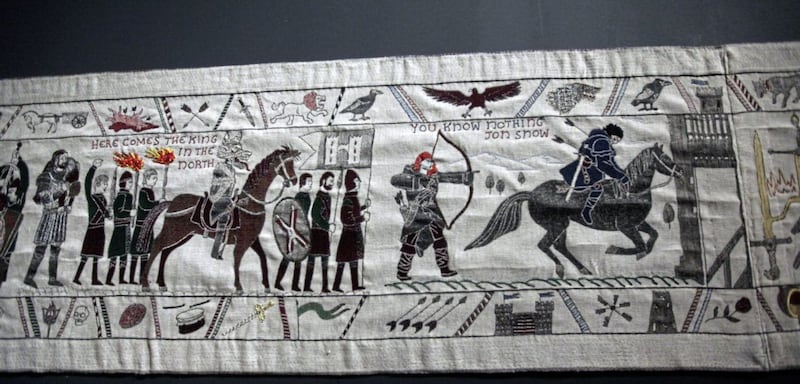EMBROIDERY may well be a lost craft in some people's minds but the centuries-old way of enhancing textiles has been used to fantastic effect on the Games Of Thrones tapestry on show at the Ulster Museum in Belfast.
Instead of sewing delicate flowers, birds or leaves – which might be considered traditional subjects for the art of embroidery – a group of 30 women have sewn crimson splodges of blood and, using perfect tiny stitches, have accentuated dragons, giants, medieval weapons and armour. They've even intricately highlighted the blonde hair of characters such as Cersei Lannister and Daenerys Targaryen, and the red locks of Sansa Stark.
In the style of the Bayeux Tapestry, the 11th century embroidered cloth that illustrates events leading up to the Norman invasion of England, the GOT tapestry depicts the main scenes from the world's most popular television series, many of them murderous or depicting battles. The series has been partly filmed here since 2010 and has already greatly broadened the north's worldwide tourism appeal.
An impressive 66m in length when unveiled last month, once series seven of Game Of Thrones ends, the completed Tourism Ireland and Tourism Northern Ireland-commissioned tapestry will be 77m long – dwarfing its famous French forebear, which clocks in at 68m.
Before being woven and embroidered, each key scene and character from the show had to be painstakingly recreated and digitally designed by artists and illustrators, condensing more than 77 hours’ of on-screen storytelling into the tapestry.
As each episode of the current series is broadcast in Ireland and Britain, sewers including Valerie Wilson and Peggy Hagan intricately embroider the Jacquard woven material from linen firm Thomas Ferguson in Banbridge.

Valerie, who's also the Ulster Museum's costume and textile curator, says that the sewers, aged from their mid-20s to 82, were garnered from the volunteers from The Embroiderers Guild and the Northern Ireland Patchwork Guild, which work closely with National Museums NI.
"The tapestry project was only offered to the museum very recently and it was accepted with the intention of engaging new audiences. We were asked not only to host the tapestry but to find a team of people who could add embroidered highlights to it,” she says.
"When I put the word out through that network, we had an amazing response. There was a real mixture on the team, of people who really knew the series plot and characters, some like me who just dipped in and out of the series, and some who hadn't watched an episode. But we always had one person each day who watched the series, which was a great help."

As with many things relating to the US television giant HBO production, secrecy was paramount.
"It was all very hush-hush and was completed in a matter of weeks for its July 17 unveiling," Valerie says. "The tapestry would come into us in 11m-long panels of material which was woven on Jacquard machines, much in the same way you would make damask linen.
“The panels were sent every few days and there would normally be about six of us working on the panel – you really couldn't have any more embroiderers working on it at the same time as everybody needed their elbow room."
Valerie studied textiles and fashion before joining the Ulster Museum and is a keen embroiderer herself. She can sometimes be seen over the weekends at the exhibition, embroidering a panel showing events from the previous week's episode.
She says that working on the Game Of Thrones tapestry has been one of the more unusual projects in her 30-year career at the museum.
"Put it this way – it's a long way from Woman's Weekly and the petit-point style of embroidery but it was fascinating," she says. “The designers sent us a really detailed plan for each feature panel where they actually selected what they wanted highlighted. As an embroiderer you never get written instructions like, ‘Use blue or green to enhance the dead girl's pallor’.
“But they trusted us to make the right colour shade choices and stitch choices.
“The choice of stitches was mostly our own. We stuck to fairly simple stitches, chain stitches, back stitch and split stitch, the sort of stitching that you would find in very old textiles or medieval textiles as it was very different to embroidering a rose on a piece of silk. It was great fun and the craic was amazing.”
Peggy (82), from Bangor, found herself to be an unlikely heroine to one of her grandsons and his friends once she revealed to her family that the secret project she had been working on involved had been the Game Of Thrones tapestry.

"I had been aware of the Game Of Thrones programme before I worked on the tapestry but the programme is not something that would actually interest me," the grandmother-of-five tells me.
"But when I told one of my grandsons, who attends the art college, he was really impressed about it and couldn't believe that I was involved in it.
"It's a great thing to have done as I suppose it's history-making in a way and I will leave a little bit of my craft behind when I'm gone."
Peggy has been involved in needlecrafts, knitting, crocheting, embroidery, lace-making and patchwork for all her life, mostly for a hobby at home but at one time professionally. She's a member of the North Down patchwork and quilting guild and a member of the lace guild based at the Folk and Transport Museum at Cultra.







